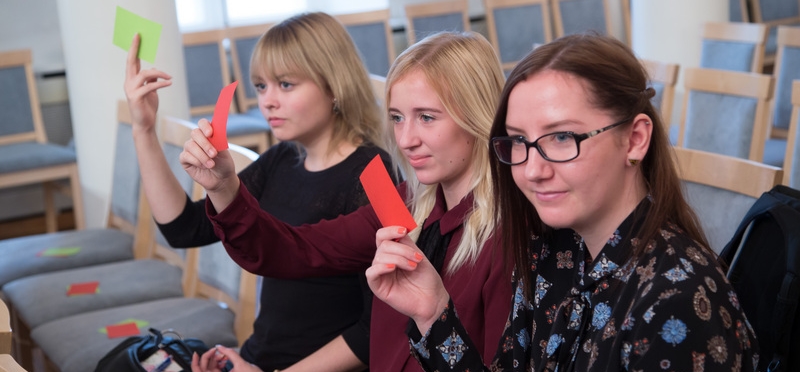- Home
- Study book
- Week 1: Introduction to multilingualism and plurilingualism
- Week 2: Understanding bilingualism
- Week 3: Multilingualism in state and society, and the role of communities
- Week 4: Early Childhood Multilingualism
- Week 5: Multilingual school
- Week 6: Multilingual higher education
- Week 7: Interculturalism and intercultural communication
- Course team

MOOC: Multilingual Education
1.2. Languages as bridges between cultures
Week 1 Part 2 will help you:
- become familiar with the concepts of multiculturalism, interculturalism and pluriculturalism,
- understand how pluricultural and intercultural competences are developed,
- get an insight into the everyday linguistic reality in an ethnic restaurant in Ljubljana, Slovenia.
To reach these goals you are expected to:
- watch the video that introduces the concepts of multiculturalism, interculturalism and pluriculturalism,
- read the paragraphs below to learn about the development of pluricultural and intercultural competences,
- watch the interview with the owner of a Lebanese restaurant in Ljubljana and check your understanding with the activity at the end of the video.
 Video
Video
 Reading
Reading
Moving between languages and cultures
According to Byram (2009), the pluriculturality of an individual can be expressed in many different ways. Some individuals express it simultaneously, regardless of the situation or context. For example, a child of a Japanese mother and an Indian father can clearly show simultaneous allegiance to the cultural heritage of both his/her parents at all times. Another way of expressing pluriculturality is by means of ‘alternation’. This is often visible in members of ethnic minorities. For instance, a teenager belonging to a minority group can adopt their own cultural practices and values at home but switch to their peer culture when at school or with friends. A third way of expressing pluriculturality that Byram (2009) mentions is ‘hybridity’. This means taking resources and elements of multiple cultures and creating ‘a novel cultural synthesis’.
Plurilingual and pluricultural competence
According to the CEFR (Council of Europe 2001, 168), plurilingual and pluricultural competence refers to the ability to use several languages and to take part in intercultural interaction. An individual with plurilingual and pluricultural competence has varying degrees of proficiency in several languages and experience of several cultures.
This means that the development of plurilingual and pluricultural competence promotes linguistic awareness, as well as the development of metacognitive strategies, which enable an individual to become aware of one’s social interactions and to control one’s own behaviour in diverse environments.
Intercultural competence
So where does the term interculturalism come in? Byram (2009) states that it is important to distinguish between the terms pluricultural and intercultural. When someone is pluricultural, it means that they are capable of identifying themselves with multiple cultures. If they are intercultural, it does not involve any identification with another cultural group nor adopting any of their practices. It simply means that intercultural individuals have the ability to experience and analyse cultural differences and use this experience to reflect on matters that are usually taken for granted in their own culture or environment. This enables them to develop tolerance of diversity and deep understanding and respect for people from other cultures. It involves a lot of interaction and exchange between different cultural groups. Since these people are able to explain and interpret different perspectives, they often act as mediators among people of different cultures. So achieving intercultural competence means developing positive attitudes towards diversity and being able to benefit and grow from contact with other cultures.
Beacco et al. (2016) encourage intercultural education and emphasize the importance of including it not only in language teaching but also in other subjects, such as history, geography or maths. In this way learners can develop intercultural competence to be able to simultaneously accommodate their own culture and that of the cultural other.
The document Competences for Democratic Culture: Living together as equals in culturally diverse democratic societies (2016, 12-3) published by the Council of Europe in addition to the CEFR (2001) and the CEFR Companion Volume (2018) outlines a conceptual model of the competences to be acquired by learners if they are to participate effectively in a culture of democracy and live peacefully together with others in culturally diverse democratic societies. This document pays special attention to values and attitudes, which, together with skills, knowledge and understanding, are necessary for functioning in democratic and intercultural situations. They include competences, such as openness to cultural otherness and to other beliefs, world views and practices, having respect for other people who are perceived to have different cultural affiliations or beliefs, positive attitudes towards a community or social group to which one belongs and awareness of other people in the community, positive attitude towards situations which are uncertain and subject to multiple conflicting interpretations etc.
Sources:
Beacco, Jean Claude et al. 2016. Guide for the development and implementation of curricula for plurilingual and intercultural education. Strasbourg: Council of Europe Publishing.
Byram, Michael. 2009. Multicultural Societies, Pluricultural People and the Project of Intercultural Education. Strasbourg: Council of Europe Publishing.
Council of Europe. 2001. Common European Framework of Reference for Languages: learning, teaching, assessment. Cambridge: CUP.
Council of Europe. 2016. Competences for Democratic Culture: Living together as equals in culturally diverse democratic societies. Strasbourg: Council of Europe Publishing.
Council of Europe. 2018. Common European Framework of Reference for Languages: learning, teaching, assessment. Companion Volume with New Descriptors. Strasbourg: Council of Europe Publishing.
|
Further reading:
Byram, Michael, Bella Gribkova, and Hugh Starkey. 2002. “Developing the intercultural dimension in language teaching.” A practical introduction for teachers. Strasbourg: Council of Europe. https://www.researchgate.net/publication/252099071_DEVELOPING_THE_INTERCULTURAL_DIMENSION_IN_LANGUAGE_TEACHING
Byram, Michael et al. 2009. Autobiography of Intercultural Encounters. Strasbourg: Council of Europe Publishing. https://rm.coe.int/context-concepts-and-theories-autobiography-of-intercultural-encounter/168089eb76


